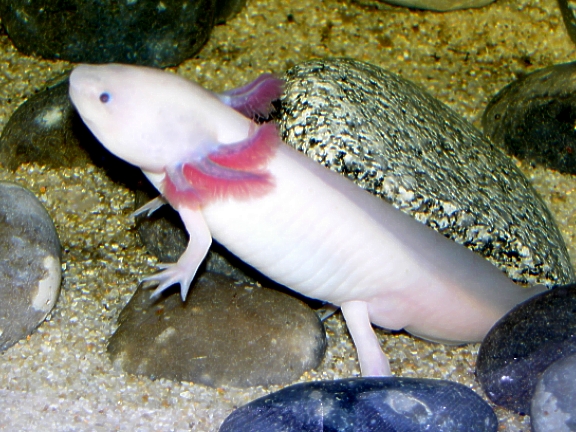Axolotls Care Facts
Axolotls (ambystoma mexicanum)
This amphibian is now an endangered species in the wild and has been classified as cites 1 listed, which means they are almost all gone from the wild. Recently there has been some activity to reintroduce them to the remaining lake areas that remain; only time will tell if this has been successful. Axolotls make a unique and interesting pet, however they are also edible and sold for food in some Mexico City markets. They reach up to 12 inches in length and 5 or 6 inches in girth and they are in fact Salamanders, and are thought to be a branch of the Tiger Salamander which has evolved along different lines probably due to environmental conditions. The ambystoma mexicanum differs from many other similar species by the number of toes on its feet; they have 5 on the hind legs and 4 on the front. They can also re-grow their limbs if they loose them.
HOUSING
Axolotls are entirely aquatic under normal circumstances and so fish tanks are the ideal home. They can reach quite a large size and the best size tank for a single adult axolotl would be 18” x 12”, and the water level need not be more than 6” to 10”. You can, if you want, keep them in a smaller tank but this may cause some stress to the animal and for the sake of a little extra money you may as well give them more freedom to move around.
Strictly speaking, the axolotl tank doesn't need to be filtered if you are prepared to remove 15 - 20 % of the water each week during a water change and clean. The time required to do water changes and cleaning can be greatly reduced if using filtration. However, keep water flow to a minimum as they do not require water Movement and can get stressed in rapid moving water. You will observe they spend most of the time in the same spot, moving their gills occasionally to disperse carbon dioxide and circulate new oxygen.
Large pebbles or very coarse aquarium gravel is preferred for the bottom of your tank. Smaller gravel or sand can cause problems for axolotls, especially if digested. A layer of smaller gravel may be used if covered by larger stones. Axolotls can be kept without any substrate at al, however much more care will need to be taken With water quality as essential bacteria is more easily maintained with a substrate. Tap water must be treated with a water conditioner before use. The water should be roughly neutral (pH 6.5 - 7.5) and maintained at a temperature of 50-68F(unheated aquaria). Too warm and the axolotl will perish, however if it is too cold, it will only slow their metabolism. Axolotls don't have any specific Lighting requirements and the fluorescent light that comes with most aquariums is perfectly adequate. They don't like bright lights, so you shouldn't use any heat Generating lights or very bright ones as their eyes have no eyelids to protect them.
FEEDING
In their native habitat, axolotls eat the abundant small fauna, including snails, worms, and crustaceans, various small invertebrates such as daphnia, and small fish and amphibian. They will in fact eat just about anything that will fit into their mouth, but this doesn’t mean they should. Generally they can be fed beef heart and other frozen or fresh carnivore’s foods. Special axolotl food is also available. Avoid feeding them mince or other budget meats as they cannot tolerate fats. Any food that the axolotl doesn't eat should be removed after 24 hours otherwise it will begin to go rotten and spoil the water quality. Similarly any solid waste material should also be removed. If your axolotl is not eating be sure to check the water quality and temperature.
GENERAL
Axolotls are unique and easy to keep. Providing you maintain their water conditions they can live for up to 15 years and make an excellent pet and companion, no biting and no claws that can hurt.
